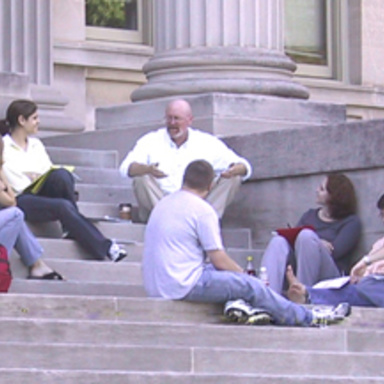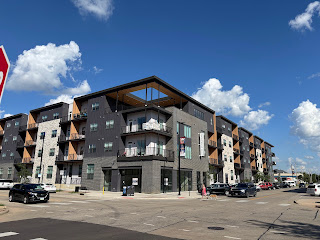 |
Bullish views of downtown Cedar Rapids were expressed by a public-private partnership of a panel Tuesday morning, sponsored by the Cedar Rapids Gazette. Mayor Tiffany O'Donnell, Jesse Thoeming of the Cedar Rapids Metro Economic Alliance, and two business owners applauded the vast increase in downtown housing and the flood protection that has enabled it, while hoping for more ideas to sustain downtown growth.
 |
| Construction underway on the "banjo block": A game-changer I can get behind |
Darryl High, a property developer and also chair of the Downtown Self-Supported Municipal Improvement District (SSMID), said downtown was at last "becoming an urban neighborhood." High cited much new construction as well as conversions of office space, concluding it will serve to "bring more people" which will eventually lead to service providers. Mayor O'Donnell anticipates a wider variety of housing that will lead to "people walking their dogs downtown." This vision of a 24-hour downtown has taken awhile to emerge, but is good to hear.
 |
| The Iowa Building (1914) is being retrofitted for housing (Google Street View screen capture) |
I make my own first entrance into it a little after eight when I put out the garbage can, surely a prosaic occupation, but I enjoy my part, my little clang, as the droves of junior high school students walk by the center of the stage dropping candy wrappers. (How do they eat so much candy so early in the morning?) (68)
Over the course of the day, the sidewalk sees elementary school students, commuters emerging from subways and taxis, shoppers, the lunchtime crowd, workers on break, children released from school, people stopping to shop on the way home, diners, and nighttime dog walkers. Her writing is so lovely, particularly considering her actual purpose is to make an argument, that I can hardly resist quoting the whole six pages. You should read them for yourself... along with the rest of this timeless book!
.png) |
| Fair question: Will Downtown residents shop at corner stores when there's a 67000 square foot Hy-Vee six minutes' drive away? |
Schumacher noted the ease of auto-commuting in the Cedar Rapids metro area means that a mobile population isn't necessarily going to stay in the downtown area. How a "vibrant, growing downtown" (High) develops within "a very suburban town" (Schumacher) is a perplexing question--really worth thinking about as the conversation shifts, as it inevitably does, to what attractions the downtown should seek. ("What are workers looking for?" asks the mayor.)
- It is possible that Cedar Rapids' core will grow through in-migration of telecommuters looking for a less expensive but still urban version of their current cities. ("Look at us! We're cheap... and kinda urban... just don't pay attention to the legislature, lol!!") Thoeming suggested doing the riverfront right could make us stand out to would-be digital nomads.
- It is possible that the much-talked-about big regional attraction, which Mayor O'Donnell thankfully has repackaged as "an entertainment complex with a casino in it," will draw residents as well as encouraging visitors to check out other downtown establishments. (Schumacher called this "a question I don't have the answer to.")
 |
| Market After Dark promo, from Cedar Rapids Downtown Farmers Market Facebook page |
- It is possible that Downtown will mostly draw people in for big events, like the farmers' market and outdoor movies, or "closing 2nd Street every once in awhile" (the mayor).
[I]t has to be multimodal. In fact, it has to have active transport priority: walking, biking and transit have to be emphasized. If you try to design density around cars, it's a recipe for failure. You have to make walking, biking and transit not just available, but delightful. (quoted in Roberts 2017)
 |
| 8th Street SE bisects an "empty quarter" between Downtown and Wellington Heights (Google Street View screen capture from May 2022) |
















